Olympic medal
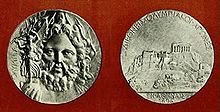 A silver medal awarded to the winner of an event at the first modern Olympic Games in 1896. | |
| Awarded for | Given to successful competitors in various Olympic Sports |
|---|---|
| Presented by | International Olympic Committee |
| History | |
| First award | 1896 |
| Website | www.olympic.org/ |
| Olympic Games |
|---|
 |
| Main topics |
| Games |
| Regional games |
| Defunct games |
An Olympic medal is awarded to successful competitors at one of the Olympic Games. There are three classes of medal to be won: gold, silver, and bronze, awarded to first, second, and third place, respectively. The granting of awards is laid out in detail in the Olympic protocols.
Medal designs have varied considerably since the Games in 1896, particularly in the size of the medals for the Summer Olympic Games. The design selected for the 1928 Games remained until its replacement at the 2004 Games in Athens, where the use of the Roman Colosseum was replaced by the Greek Panathenaic Stadium,[1] appropriate to represent Olympic values. The medals of the Winter Olympic Games never had a common design, but regularly feature snowflakes and the event where the medal has been won.
In addition to generally supporting their Olympic athletes, some countries provide sums of money and gifts to medal winners, depending on the classes and number of medals won.[2] In the 2024 Paris Games, 33 countries confirmed that they would award prizes to medallists, with 15 awarding cash prizes over $100,000.[3]
Introduction and early history
[edit]The olive wreath was the prize for the winner at the Ancient Olympic Games. It was an olive branch, off the wild-olive tree that grew at Olympia,[4] intertwined to form a circle or a horse-shoe. According to Pausanias, it was introduced by Heracles as a prize for the winner of the running race to honour Zeus.[5]
When the modern Olympic Games began in 1896 medals started to be given to successful olympian competitors. However, gold medals were not awarded at the inaugural Olympics in 1896 in Athens, Greece.[6] The winners were instead given a silver medal and an olive branch,[7] whilst runners-up received a laurel branch and a copper or bronze medal.[8]

The 1900 Summer Olympics is unique in being the only Olympic Games to feature rectangular medals, which were designed by Frédérique Vernon.[9] Gilt silver medals were awarded for 1st place in shooting, lifesaving, automobile racing and gymnastics.[10][11] Second place silver medals were awarded in shooting, rowing, yachting, tennis, gymnastics, sabre, fencing, equestrian and athletics.[12] Third place bronze medals were awarded in gymnastics, firefighting and shooting.[13][14] In many sports, however, medals were not awarded. With most of the listed prizes being cups and other trophies.[15]
The custom of the sequence of gold, silver, and bronze for the first three places in all events dates from the 1904 Summer Olympics in St. Louis, Missouri in the United States. The International Olympic Committee (IOC) has retroactively assigned gold, silver and bronze medals to the three best-placed athletes in each event of the 1896 and 1900 Games.[16][15] If there is a tie for any of the top three places all competitors are entitled to receive the appropriate medal according to IOC rules.[17] Some combat sports (such as boxing, judo, taekwondo and wrestling) award two bronze medals per competition, resulting in, overall, more bronze medals being awarded than the other colours.
Medals are not the only awards given to competitors; every athlete placed first to eighth receives an Olympic diploma. Also, at the main host stadium, the names of all medal winners are written onto a wall.[17] Finally, as noted below, all athletes receive a participation medal and diploma.
Production and design
[edit]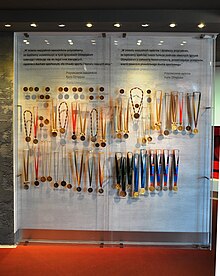
The IOC dictates the physical properties of the medals and has the final decision about the finished design. Specifications for the medals are developed along with the National Olympic Committee (NOC) hosting the Games, though the IOC has brought in some set rules:[17][18]
- Recipients: The top three competitors receive medals
- Shape: Usually circular, featuring an attachment for a chain or ribbon
- Diameter: A minimum of 60 mm
- Thickness: A minimum of 3 mm
- Material:
- First place (the gold medal): It is composed at least 92.5% of silver, plated with 6 grams of gold; the metal value was about US$494 in 2010.[19][20] At the 2020 Summer Olympics held in 2021 in Tokyo, Japan, the medal at then-current prices was worth about $800.[21]
- Second place (the silver medal): 92.5% silver;[22] the metal value was about US$260 in 2010.[19] At the Tokyo games, the medal was worth $460.[21]
- Third place (the bronze medal): In 2010 it was 97% copper with 0.5% tin and 2.5% zinc; the metal value was about US$3 in 2010.[19] At the Tokyo games it was 95% copper and 5% zinc with a metal value of about $5.[21]
- Event details: The sport for which the medal has been awarded should be written on the medal.
The first Olympic medals in 1896 were designed by French sculptor Jules-Clément Chaplain and depicted Zeus holding Nike, the Greek goddess of victory, on the obverse and the Acropolis on the reverse.[6] They were made by the Paris Mint, which also made the medals for the 1900 Olympic Games, hosted by Paris. This started the tradition of giving the responsibility of minting the medals to the host city. For the next few Olympiads, the host city also chose the medal design. Until 1912 the gold medals were made of solid gold.[23]
Trionfo
[edit]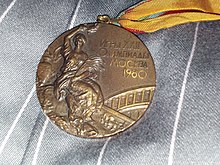
In 1923 the International Olympic Committee (IOC) launched a competition for sculptors to design the medals for the Summer Olympic Games. Giuseppe Cassioli's Trionfo design was chosen as the winner in 1928.[6][24][25] The obverse brought back Nike but this time as the main focus, holding a winner's crown and palm with a depiction of the Colosseum in the background.[24] In the top right section of the medal, a space was left for the name of the Olympic host and the Games numeral.
The reverse features a crowd of people carrying a triumphant athlete. His winning design was first presented at the 1928 Summer Olympics in Amsterdam. The medals for the 1960 Games in Rome inverted the design, with the obverse featuring the crowd and the reverse featuring Nike.[26] The competition saw this design used for 40 years until the 1972 Summer Olympics in Munich became the first Games with a different design for the reverse side of the medal.[6]
Cassioli's design continued to inspire the obverse of the medal for many more years, though recreated each time, with the Olympic host and numeral updated. The obverse remained true to the Trionfo design until the 1992 Summer Olympics in Barcelona, Spain, where the IOC allowed an updated version to be created. For the next few events , they mandated the use of the Nike motif but allowed other aspects to change.[18]
The trend ended after 2000, due to the negative reaction to the medal design for the 2000 Summer Olympics in Sydney. The designer of the 2000 medal (Wojciech Pietranik) had originally featured the Sydney Opera House on the obverse instead of the traditional Roman Colosseum but the International Olympic Committee decided that the Colosseum should remain.[27] The Greek press criticised the design for ignorance of the birthplace of the Olympic Games, pointing out that the long-standing feature on the front of medals was mistakenly depicting the Roman Colosseum rather than the Greek Parthenon.[6][28] The Sydney Organising Committee decided to continue with the design as it was, noting that there was insufficient time to complete another version and that it would be too costly.[18] After 76 years a new style by designer Elena Votsi depicting the Panathenaic Stadium was introduced at the 2004 Summer Olympics in Athens.[29] This new obverse design remains in use.
Custom reverse designs
[edit]The German Olympic Committee, Nationales Olympisches Komitee für Deutschland, was the first Summer Games organisers to elect to change the reverse of the medal. The 1972 design was created by Gerhard Marcks, an artist from the Bauhaus, and features mythological twins Castor and Pollux.[30] Since then the Organising Committee of the host city has been given the freedom of the design of the reverse, with the IOC giving final approval.
Comparison between Summer and Winter
[edit]The IOC has the final decision on the specifications of each design for all Olympic medals, including the Summer Games, Winter Games, Summer Paralympic Games and Winter Paralympic Games. There has been a greater variety of design applications for the Winter Games; unlike with the Summer Games, the IOC never mandated one particular design. The medal at the inaugural 1924 Winter Olympics in Chamonix, France did not even feature the Olympic rings. Nike was featured on the medals of the 1932 and 1936 Games but has only appeared on one medal design since then. One regular motif is the use of the snowflake, while laurel leaves and crowns appear on several designs. The Olympic motto Citius, Altius, Fortius features on four Winter Games medals but does not appear on any Summer Games medal.
For three events in a row, hosts of the Winter Games included different materials in the medals: glass (1992), sparagmite (1994), and lacquer (1998). It was not until the 2008 Summer Olympics in Beijing, China that a Summer Olympic host chose to use something different, in this case, jade. While every Summer Olympic medal except for the 1900 Games has been circular, the shapes of the Winter Games have been considerably more varied. The designs for the Winter Games medals are also generally larger, thicker, and heavier than those for the Summer Games.
Individual design details
[edit]Summer Olympic medal designs
[edit]Details about the medals from each of the Summer Olympic Games:[30][31]
| Games | Host | Details | Designer(s) | Mint | Diameter (mm) |
Thickness (mm) |
Weight (g) |
image |
|---|---|---|---|---|---|---|---|---|
| 1896 | Athens, Greece | Obverse: Zeus holding Nike Reverse: The Acropolis of Athens |
Jules-Clément Chaplain | Paris Mint | 48 | 3.8 | 47 | 
|
| 1900 | Paris, France | Obverse: Winged goddess (possibly Nike) holding laurel branches; Paris in the background Reverse: A victorious athlete holding a laurel branch; the Acropolis in the background Note: The only Summer Olympic medal that is not circular |
Frédérique Vernon | Paris Mint | 59 x 41 | 3.2 | 53 |  |
| 1904 | St. Louis, Missouri, U.S. | Obverse: Nike holding a laurel crown and a palm leaf Reverse: An athlete holding a laurel crown; Greek temple in the background |
Dieges & Clust | Dieges & Clust | 37.8 | 3.5 | 21 | 
|
| 1908 | London, Great Britain | Obverse: An athlete receiving a laurel crown from two female figures Reverse: Saint George atop a horse Edge: "Vaughton", event name and winner |
Bertram Mackennal | Vaughton & Sons | 33 | 4.4 | 21 | 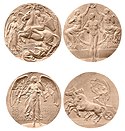 |
| 1912 | Stockholm, Sweden | Obverse: An athlete receiving a laurel crown from two female figures Reverse: A herald opening the Games with a statue of Pehr Henrik Ling behind him |
Bertram Mackennal (obverse) Erik Lindberg (reverse) |
C.C. Sporrong & Co | 33.4 | 1.5 | 24 |  |
| 1920 | Antwerp, Belgium | Obverse: An athlete holding a laurel crown and a palm leaf Reverse: Statue of Silvius Brabo Edge: Name, event, team, "Antwerp", and the date |
Josuë Dupon | Coosmans | 59 | 4.4 | 79 | |
| 1924 | Paris, France | Obverse: An athlete helping another to stand Reverse: A harp and various items of sports equipment |
André Rivaud | Paris Mint | 55 | 4.8 | 79 |  |
| 1928 | Amsterdam, Netherlands | Design: Trionfo Note: This obverse design, sometimes recreated, remains until 2004, the reverse design remained until 1972 |
Giuseppe Cassioli | Dutch State Mint | 55 | 3 | 66 |  |
| 1932 | Los Angeles, California, U.S. | Design: Trionfo | Giuseppe Cassioli | Whitehead & Hoag | 55.3 | 5.7 | 96 | |
| 1936 | Berlin, Germany | Design: Trionfo | Giuseppe Cassioli | B.H. Mayer | 55 | 5 | 71 | 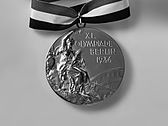 |
| 1948 | London, Great Britain | Design: Trionfo | Giuseppe Cassioli | John Pinches | 51.4 | 5.1 | 60 | 
|
| 1952 | Helsinki, Finland | Design: Trionfo Edge: 916 M / Y6 (Factory Stamp) |
Giuseppe Cassioli | Kultakeskus Oy | 51 | 4.8 | 46.5 | |
| 1956 | Melbourne, Australia | Design: Trionfo | Giuseppe Cassioli | K.G. Luke | 51 | 4.8 | 68 | |
| 1960 | Rome, Italy | Design: Trionfo Surround: A bronze laurel wreath and laurel leaf chain (The Rome games were the first to place the medal around the athletes neck) |
Giuseppe Cassioli | Artistice Fiorentini | 68 | 6.5 | 211 | 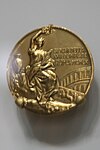 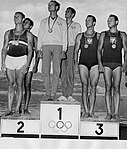
|
| 1964 | Tokyo, Japan | Design: Trionfo | Giuseppe Cassioli and Toshikaka Koshiba | Japan Mint | 60 | 7.5 | 62 | 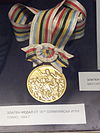
|
| 1968 | Mexico City, Mexico | Design: Trionfo | Giuseppe Cassioli | 60 | 6 | 130 | 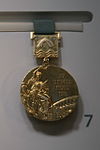
| |
| 1972 | Munich, West Germany | Obverse: Trionfo Reverse: Castor and Pollux, twin sons of Zeus and Leda Edge: Winner's name and sport |
Giuseppe Cassioli (obverse) Gerhard Marcks (reverse) |
Bavarian Mint | 66 | 6.5 | 102 |  |
| 1976 | Montreal, Quebec, Canada | Obverse: Trionfo Reverse: A stylised laurel crown and the Montreal Games logo Edge: Name of the sport |
Giuseppe Cassioli (obverse) | Royal Canadian Mint | 60 | 5.8 | 154 | |
| 1980 | Moscow, Russia | Obverse: Trionfo Reverse: A stylised Olympic flame and the Moscow Games logo |
Giuseppe Cassioli (obverse) Ilya Postol (reverse) |
Moscow Mint | 60 | 6.8 | 125 | 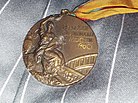 |
| 1984 | Los Angeles, California, U.S. | Obverse: Trionfo Reverse: An Olympic champion held aloft by a crowd Note: The reverse returns to the Cassioli design |
Giuseppe Cassioli | Jostens, Inc | 60 | 7.9 | 141 | |
| 1988 | Seoul, South Korea | Obverse: Trionfo Reverse: An outline of a dove carrying a laurel branch and the Seoul Olympic logo |
Giuseppe Cassioli (obverse) | Korea Minting and Security Printing Corporation | 60 | 7 | 152 | |
| 1992 | Barcelona, Spain | Obverse: Updated interpretation of Trionfo Reverse: Barcelona Games logo |
Xavier Corbero | Royal Mint of Spain | 70 | 9.8 | 231 | |
| 1996 | Atlanta, U.S. | Obverse: Updated interpretation of Trionfo Reverse: A stylised olive branch, the Atlanta Games logo, and "Centennial Olympic Games" Edge: "Atlanta Committee for the Olympic Games" |
Malcolm Grear Designers | Reed & Barton | 70 | 5 | 181 |  |
| 2000 | Sydney, Australia | Obverse: Updated interpretation of Trionfo Reverse: The Sydney Opera House, Olympic Flame, and Olympic rings Edge: Event name |
Wojciech Pietranik | Royal Australian Mint | 68 | 5 | 180 | |
| 2004 | Athens, Greece | Obverse: Nike of Paionios with Panathenaic Stadium and the Acropolis of Athens in the background Reverse: The Olympic Flame, the opening lines of Pindar's Eighth Olympic Ode, and the Athens Games logo |
Elena Votsi | Efsimon | 60 | 5 | 135 | |
| 2008 | Beijing, China | Obverse: Nike with Panathenaic Stadium and the Acropolis of Athens in the background Reverse: A jade ring with the Beijing Games logo in the centre and the event details on the outer edge |
Xiao Yong[32] | China Banknote Printing and Minting Corporation | 70 | 6 | 200 |  |
| 2012 | London, United Kingdom | Obverse: Nike with Panathenaic Stadium and the Acropolis of Athens in the background Reverse: The River Thames and the London Games logo with angled lines in the background |
David Watkins | Royal Mint | 85 | 8–10 | 357–412[33] |  |
| 2016 | Rio de Janeiro, Brazil | Obverse: Nike with Panathenaic Stadium and the Acropolis of Athens in the background Reverse: The Rio 2016 logo and name, surrounded by a laurel leaf design in the form of the wreaths Edge: The name of the event for which the medal was won is engraved by laser along the outside edge. Note: For the first time, the medals are slightly thicker at their central point compared with their edges.[34] |
Chelles and Hayashi | Casa da Moeda do Brasil | 85 | 6–11[35] | 500[36] | |
| 2020 | Tokyo, Japan | Obverse: Nike with Panathenaic Stadium and the Acropolis of Athens in the background Reverse: The Tokyo 2020 logo and name, surrounded by rays of sun. |
Junichi Kawanishi[37] | Japan Mint[38] | 85 | 7.7–12.1 | 450–556 |  |
| 2024 | Paris, France | Obverse: Nike with Panathenaic Stadium, the Acropolis of Athens, and the Eiffel Tower in the background, surrounded by rays Reverse: Hexagonal tokens of iron taken from the original construction of the Eiffel Tower engraved with the Paris 2024 logo, surrounded by rays |
Chaumet[39] | Monnaie de Paris[40] | 85 | 9.2 | 455–529 |
Winter Olympic medal designs
[edit]Details about the medals from each of the Winter Olympic Games:[6][41]
| Games | Host | Details | Designer(s) | Mint[17] | Diameter (mm) |
Thickness (mm) |
Weight (g) |
Image |
|---|---|---|---|---|---|---|---|---|
| 1924 | Chamonix, France | Obverse: A skier holding skates and skis and the designer's name Reverse: Written information about the Games |
Raoul Bénard | Paris Mint | 55 | 4 | 75 | |
| 1928 | St. Moritz, Switzerland | Obverse: A skater surrounded by snowflakes Reverse: Olive branches and host details |
Arnold Hunerwadel | Huguenin Frères | 50.4 | 3 | 51 | |
| 1932 | Lake Placid, U.S. | Obverse: Nike with the Adirondack Mountains in the background Reverse: Laurel leaves and written host details Shape: Circular but not with a straight edge |
Robbins Company | 55 | 3 | 51 | ||
| 1936 | Garmisch-Partenkirchen, Germany | Obverse: Nike atop a horse-drawn chariot traversing an arch over winter sporting equipment Reverse: Large Olympic rings |
Richard Klein | Deschler & Sohn | 100 | 4 | 324 | |
| 1948 | St. Moritz, Switzerland | Obverse: The Olympic torch with snowflakes in the background and the Olympic motto Citius, Altius, Fortius Reverse: A snowflake and written host details |
Paul Andre Droz | Huguenin Frères | 60.2 | 3.8 | 103 | |
| 1952 | Oslo, Norway | Obverse: The Olympic torch and the Olympic motto Citius, Altius, Fortius Reverse: A pictogram of Oslo City Hall with three snowflakes and written host details |
Vasos Falireus and Knut Yvan | Th. Marthinsen | 70 | 3 | 137.5 | |
| 1956 | Cortina d'Ampezzo, Italy | Obverse: An "ideal woman" and written host details Reverse: A large snowflake with Pomagagnon in the background, the Olympic motto Citius, Altius, Fortius, and further host details |
Costanttino Affer | Lorioli Bros. | 60.2 | 3 | 120.5 | 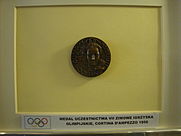 |
| 1960 | Squaw Valley, U.S. | Obverse: The head of a male and female with host details written around them Reverse: Large Olympic rings, the Olympic motto Citius, Altius, Fortius, and the name of the sport |
Herff Jones | Herff Jones Company | 55.3 | 4.3 | 95 |  |
| 1964 | Innsbruck, Austria | Obverse: Torlauf Mountains, "Innsbruck 1964", and "Torlauf" Reverse: The Olympic rings above the emblem of Innsbruck with host details around them |
Martha Coufal (obverse) Arthur Zegler (reverse) |
Austrian Mint | 72 | 4 | 110 | 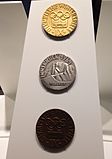 |
| 1968 | Grenoble, France | Obverse: Three snowflakes and the red rose emblem of Grenoble surrounded by host details Reverse: A stylised image of each sport |
Roger Excoffon | Paris Mint | 61 | 3.3 | 124 | 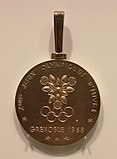 |
| 1972 | Sapporo, Japan | Obverse: Pictogram of lines in the snow Reverse: A snowflake, the Sun, and the Olympic rings Shape: Square with rounded, wavy lines |
Yagi Kazumi (obverse) Ikko Tanaka (reverse) |
Mint Bureau of the Finance Ministry | 57.3 x 61.3 | 5 | 130 | 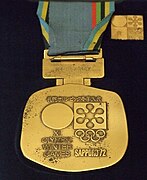 |
| 1976 | Innsbruck, Austria | Obverse: The Olympic rings above the emblem of Innsbruck with host details around them Reverse: The Alps, Bergisel, and the Olympic flame |
Martha Coufal (obverse) Arthur Zegler (reverse) |
Austrian Mint | 70 | 5.4 | 164 | |
| 1980 | Lake Placid, U.S. | Obverse: The Olympic torch held in front of the Adirondack Mountains Reverse: A pine cone sprig and the Lake Placid logo |
Gladys Gunzer | Medallic Art Company | 81 | 6.1 | 205 | |
| 1984 | Sarajevo, Yugoslavia | Obverse: Event logo with host details surrounding it Reverse: An athlete's head wearing a laurel crown Shape: Circular but set in a large rounded rectangular shape |
Nebojša Mitrić | Zlatara Majdanpek and Zavod za izradu novčanica | 71.1 x 65.1 | 3.1 | 164 | 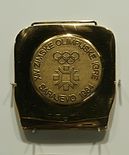 |
| 1988 | Calgary, Alberta, Canada | Obverse: Event logo with host details surrounding it Reverse: Two people, one wearing a laurel and the other wearing a headdress made up of winter sports equipment |
Fridrich Peter | Jostens | 69 | 5 | 193 | |
| 1992 | Albertville, France | Obverse: Glass set into the metal, showing the Olympic rings in front of mountains Reverse: Rear side of glass section |
René Lalique | René Lalique | 92 | 9.1 | 169 | |
| 1994 | Lillehammer, Norway | Sparagmite partially covered in gold, one side showing the Olympic rings and host details, the other depicting the sport in which the medal was won and the Games emblem | Ingjerd Hanevold | Th. Marthinsen | 80 | 8.5 | 131 | |
| 1998 | Nagano, Japan | Obverse: Partly lacquered, shows the Games emblem Reverse: Mainly lacquer, containing the Games emblem over the Shinshu mountains |
Takeshi Ito | Kiso Kurashi Craft Center | 80 | 8 | 261 | 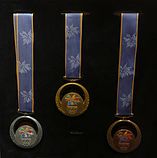 |
| 2002 | Salt Lake City, U.S. | Obverse: An athlete carrying the Olympic torch steps out of flames Reverse: Nike holding a victory leaf surrounded by event details Shape: Irregular circle, like the rocks in Utah's rivers |
Scott Given, Axiom Design | O.C. Tanner | 85 | 10 | 567 | 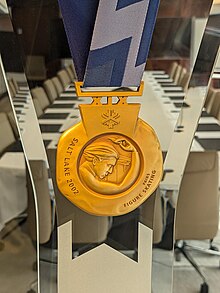    |
| 2006 | Turin, Italy | Obverse: Graphic elements of the Games Reverse: Pictogram of the specific event Edge: words "XX Olympic Winter Games" in Italian, English, and French Shape: Circular with a hole representing a piazza |
Dario Quatrini | Ottaviani | 107 | 10 | 469 | |
| 2010 | Vancouver, British Columbia, Canada | Obverse: An individually cropped section of a large First Nations artwork (orca or raven), making each medal unique Reverse: Emblem of the Games and event details Shape: Circular but with undulations stopping it from being flat |
Corrine Hunt and Omer Arbel | Royal Canadian Mint | 100 | 6 | 500–576 | |
| 2014 | Sochi, Russian Federation | Obverse: "Patchwork quilt" design representing different regions of Russia Reverse: Name of the competition in English and the Sochi logo Edge: words "XXII Olympic Winter Games" in Russian, English, and French Shape: Circular |
ADAMAS | ADAMAS[42] | 100 | 10 | 460, 525, 531 |  |
| 2018 | Pyeongchang County, South Korea | Obverse: Abstract design resembling ripples in a field of snow Reverse: Hangul messages "symbolising the effort of athletes from around the world"[43] |
Lee Suk-woo | 92.5 | 586, 580, 493 | 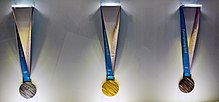 | ||
| 2022 | Beijing, China | Obverse: The Olympic Rings and "XXIV Olympic Winter Games Beijing 2022" surrounded by traditional Chinese art of stars and clouds inside concentric circles Reverse: A stylized depiction of the Solar System around the logo, marking the Games coinciding with Chinese New Year festivities[44] |
Hang Hai |
Participation medals
[edit]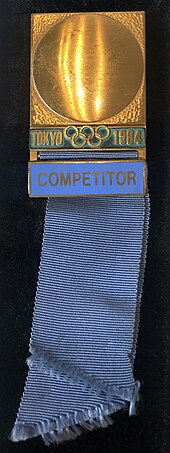
Since the beginning of the modern Olympics the athletes and their support staffs, event officials, and certain volunteers involved in planning and managing the games have received commemorative medals and diplomas. Like the winners' medals, these are changed for each Olympic Festival, with different ones issued for the summer and winter games.[45]
Gallery
[edit]-
Reverse of the plaque from the 1900 Olympic Games in France
-
James Graves wearing a bronze medal at the 2000 Summer Olympics, the last version of the Trionfo design
-
Vincent Hancock with his gold medal at the 2012 Summer Olympics, the heaviest Summer Olympics medal prior to the 2016 Rio Olympics[46]
Presentation
[edit]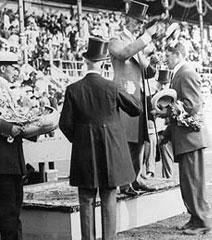
The presentation of the medals and awards varied significantly until the 1932 Summer Olympics in Los Angeles brought in what has now become standard. Before 1932 all the medals were awarded at the closing ceremony, with the athletes wearing evening dress for the first few Games. Originally the presenting dignitary was stationary while the athletes filed past to receive their medals. The victory podium was introduced upon the personal instruction in 1931 of Henri de Baillet-Latour, who had seen one used at the 1930 British Empire Games.[47] The winner is in the middle at a higher elevation, with the silver medallist to the right and the bronze to the left.[47] At the 1932 Winter Olympics, medals were awarded in the closing ceremony, with athletes for each event in turn mounting the first-ever podium. At the 1960 Summer Olympics, competitors in the Stadio Olimpico received their medals immediately after each event for the first time; competitors at other venues came to the Stadio Olimpico the next day to receive their medals.[17][47] Later Games have had a victory podium at each competition venue.
The 1960 Summer Olympics in Rome, Italy were the first in which the medals were placed around the neck of the athletes. The medals hung from a chain of laurel leaves, while they are now hung from a coloured ribbon.[30] When Athens hosted the 2004 Summer Olympics the competitors on the podium also received an olive wreath crown. In the 2016 Summer Olympics in Rio de Janeiro, each medalist received a wooden statuette of the Olympic logo.[48]
It is customary for many medals at the Winter Olympics to be presented in a separate ceremony on the evening of or the evening after competition. At the 2002 Winter Olympics in Salt Lake City, the "medals plaza" was popularized as a way for the public to see presentations that would have otherwise taken place at far-flung, low-capacity or high-altitude venues and to have an evening program that often included musical performances.
See also
[edit] Olympics portal
Olympics portal- Lists of Olympic medalists
- Olympic Cup
- Olympic diploma
- Olympic Diploma of Merit
- Olympic Laurel
- Olympic Order
- Summer Olympic coins
- Winter Olympic coins
- James Brendan Connolly, recipient of the first winner's medal
- Pierre de Coubertin Medal, a special medal awarded by the International Olympic Committee for sportsmanship or exceptional service to the Olympic movement
References
[edit]- ^ "Athens 2004, the medals". Olympics.com. Retrieved 6 August 2024.
- ^ Stewart, Emily (22 July 2021). "The price of Olympic glory". Vox. Retrieved 26 July 2021.
- ^ "The prizes Olympic athletes can win if they bring home medals". Sky News. Retrieved 4 August 2024.
- ^ Theophrastus, Enquiry into Plants, IV.13.2: 'the wild-olive [kotinos] at Olympia near the temple of zeus, from which the wreaths for the games are made".
- ^ Pausanias, Description of Greece, 5.7.7
- ^ a b c d e f "London 2012: Olympic medals timeline". BBC News. 26 July 2011. Retrieved 27 July 2011.
- ^ De Coubertin, Pierre; Timoleon J. Philemon; N.G. Politis; Charalambos Anninos (1897). The Olympic Games: BC 776–AD 1896 (PDF). The Olympic Games in 1896 - Second Part. Athens: Charles Beck. pp. 232–4. Archived from the original (PDF) on 1 August 2007.
- ^ "After this followed the distribution of the second prizes. The King presented each winner a bronze medal and a laurel branch". (English version) But: "Darauf treten die zweiten Sieger einzeln heran und empfangen aus den Händen des Königs einen Lorbeerzweig und eine kupferne Medaille" (German version) Pierre de Coubertin and others, The Olympic Games In 1 8 9 6, Archived 1 August 2007 at the Wayback Machine, Athens, London, Leipzig 1897, p.114 and p. 115. In: The Olympic Games B.C. 776. — A. D. 1896. Part II
- ^ "Paris 1900 the Medals". International Olympic Committee. 16 December 2020. Retrieved 12 August 2021.
- ^ Greensfelder, Jim; Vorontsov, Oleg; Lally, Jim (1998). Olympic Medals: a reference guide. GVL Enterprises. pp. 9–10.
- ^ "Olympic Summer Games Medals from Athens 1896 to Tokyo 2020" (PDF). Olympic Studies Centre. Archived (PDF) from the original on 3 September 2020. Retrieved 13 August 2021.
- ^ Greensfelder, Jim; Vorontsov, Oleg; Lally, Jim (1998). Olympic Medals: a reference guide. GVL Enterprises. pp. 9–10.
- ^ "Olympic Summer Games Medals from Athens 1896 to Tokyo 2020" (PDF). Olympic Studies Centre. Archived (PDF) from the original on 3 September 2020. Retrieved 13 August 2021.
- ^ Greensfelder, Jim; Vorontsov, Oleg; Lally, Jim (1998). Olympic Medals: a reference guide. GVL Enterprises. pp. 9–10.
- ^ a b Mallon, Bill (1998). The 1900 Olympic Games, Results for All Competitors in All Events, with Commentary. Jefferson, North Carolina: McFarland & Company, Inc., Publishers. ISBN 0-7864-0378-0.
- ^ "Athens 1896–Medal Table". International Olympic Committee. Retrieved 5 May 2008.
- ^ a b c d e Report 268. International Olympic Committee. 31 January 2002. Retrieved 16 May 2021.
- ^ a b c The fine art of victory, Archived 17 July 2005 at the Wayback Machine. Powerhouse Museum. Retrieved 11 September 2011.
- ^ a b c Rigel Celeste (2 May 2010). "How Much is a Gold Medal Really Worth?". Luxist. Archived from the original on 21 May 2013. Retrieved 14 August 2016.
- ^ "Olympic Minerals: The Medals". 4 February 2005. Archived from the original on 4 February 2005. Retrieved 12 October 2021.
- ^ a b c "How much are Olympic medals worth?". CNN. 31 July 2021. Retrieved 1 August 2021.
- ^ "The Live Updating Scrap Gold Value Calculator - Dendritics [USD]".
- ^ "Olympics 2016: Everything You Need to Know About Gold Medals". ABC News. 12 August 2016. Retrieved 14 August 2016.
- ^ a b Winner's medal for the 1948 Olympic Games in London, Olympic.org. Retrieved 5 August 2011.
- ^ Olympic Summer Games Medals, Athens Info Guide. Retrieved 27 July 2011.
- ^ IOC (17 December 2020). "Rome 1960 Olympic Medals - Design, History & Photos". Olympics.com. Retrieved 19 September 2021.
- ^ The fine art of victory, Archived 17 July 2005 at the Wayback Machine. Powerhouse Museum. Accessed 11 September 2011.
- ^ Greek anger at Olympic medal design, The Telegraph. Retrieved 5 August 2011.
- ^ Athens' New Olympic Medal Design Win IOC's Nod, People Daily. Retrieved 5 August 2011.
- ^ a b c IOC: All Medals. International Olympic Committee. Retrieved 27 July 2021.
- ^ Magnay, Jacquelin. London 2012 Olympics: medal designs unveiled. The Telegraph. 27 July 2011. Retrieved 11 September 2011.
- ^ Xiao Yong Archived 27 August 2011 at the Wayback Machine. icograda. Retrieved 11 September 2011.
- ^ The Making of the London 2012 Victory Medals Archived 13 August 2016 at the Wayback Machine. The Royal Mint. Retrieved 12 August 2016.
- ^ Rio 2016 reveals Olympic medals, celebrating nature and sustainability Archived 15 August 2016 at the Wayback Machine. Rio 2016. 14 June 2016. Retrieved 13 August 2016.
- ^ Medalhas Olímpicas e Paralímpicas são as mais sustentáveis da história dos Jogos. Casa da Moeda do Brasil. 14 June 2016. Retrieved 13 August 2016.
- ^ Innovative Medal Design Unveiled for Rio 2016. International Olympic Committee. 15 June 2016. Retrieved 12 August 2016.
- ^ Tokyo 2020 Olympic Medal Design Archived 22 July 2021 at the Wayback Machine.Tokyo 2020. 25 July 2019. Retrieved 25 July 2021.
- ^ Behind the Making of the Tokyo 2020 Medals. nippon.com 20 August 2019. Retrieved 25 July 2021.
- ^ Paris 2024 Olympic Medal Design
- ^ Theissen, Marion (18 July 2024). "Paris 2024: the Olympic and Paralympic medals have been revealed". SportsTiger. Archived from the original on 18 July 2024. Retrieved 18 July 2024.
- ^ Olympic Winter Games Medals from Chamonix 1924 to Vancouver 2010. Archived 16 October 2011 at the Wayback Machine. International Olympic Committee. April 2011. Retrieved 11 September 2011.
- ^ The Sochi Olympic medals introduced by the ADAMAS jewellery company on YouTube
- ^ "PyeongChang 2018 Olympic Medal Table - Gold, Silver & Bronze".
- ^ "Beijing 2022 Olympic medals design unveiled with 100 days to go". Beijing2022.cn. Archived from the original on 28 October 2021. Retrieved 26 October 2021.
- ^ Olympic Museum
- ^ "London's Olympic Gold Medal Worth the Most in the History of the Games". Forbes.
- ^ a b c Barney, Robert K. (1998). "A Research Note on the Origins of the Olympic Victory Podium" (PDF). International Symposium for Olympic Research. Fourth: Global and Cultural Critique: Problematizing the Olympic Games: 219–226. Archived from the original (PDF) on 2 February 2014. Retrieved 12 September 2013.
- ^ "What's the little figurine athletes are receiving with their medals in Rio?". ABC News. 16 August 2016.

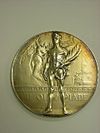
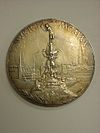


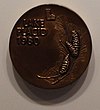





![Vincent Hancock with his gold medal at the 2012 Summer Olympics, the heaviest Summer Olympics medal prior to the 2016 Rio Olympics[46]](http://up.wiki.x.io/wikipedia/commons/thumb/b/b5/Vincent_Hancock_wins_Olympic_gold.jpg/120px-Vincent_Hancock_wins_Olympic_gold.jpg)

